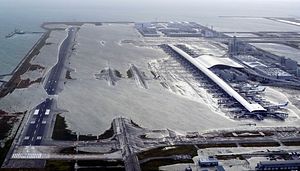Japan’s sophisticated rail networks demonstrate the value of redundancy during post-disaster recovery, whereas the recent closure of the Kansai Airport, and lack of adequate alternative options, serves as a cautionary tale. In both cases, Japanese experiences with infrastructure development and disaster planning can be helpful for Southeast Asia.
Aside from casualties and damages, the flooding in Western Japan in July disrupted rail transportation, including freight services. Although Japan Rail Freight (JRF) has not been the same mainstay of land transport as it was in the 1950s and 1960s, JRF’s services are still crucial for Japan’s economy, particularly in manufacturing for moving bulky materials, parts and products.
The flooding significantly damaged various sections of the Sanyo Mainline (山陽本線), an economic artery between Kyushu and the Kinki region of Honshu, and repairs would take months to complete. Based on the linear nature of it, only a section of disruption is enough to deny JRF services. As highways and Shinkansen (high-speed rails, HSR) can take over passenger services, shifting a large amount of JRF services onto trucks would overload the highway network with more costs.
Fortunately, a parallel rail line, Sanin Main Line (山陰本線)provides an alternative, despite lack of electrification which does not allow electric locomotives to operate. After the deployment of diesel locomotives and other arrangements, the JRF began alternative services to maintain continuous economic linkages between Honshu and Kyushu last month. Usually, the Sanin Main Line is mainly for passenger services with limited revenue due to the low population along the line, but it has also served a role as a strategic option, not only now but also following the Great Hanshin Earthquake of 1995.
This example of a flexible rail network is meaningful for Southeast Asian countries which are undergoing an expansion of rail systems. Except for a few countries, such as Singapore and Brunei, railways in regional countries are vulnerable to natural disasters, like earthquakes and typhoons in addition to man-made damage, such as from terrorist attacks. As such, ensuring a certain redundancy in rail networks will ensure resilience during and after crises, and conventional rail networks are more likely to achieve this.
HSR lines are iconic, but their high costs in some cases would not allow the formation of a large enough network which contains alternative routes in the foreseeable future. In contrast, to upgrade and expand the current network of narrow gauge rails would strengthen regional countries’ capacity for land transport at a more acceptable cost. As most regional conventional rail networks are constituted with single truck lines rather than parallel arrangements such as the Sanin Main Line, there is plenty of space for expansion. Unlike Japan, with sluggish economic growth and a shrinking population, the rising economy and expanding populations in most Southeast Asian countries would make such construction wise, with the anticipation that demand for land transportation will also rise. Moreover, building additional lines would promote more balanced development across different regions.
There are also lessons to be drawn from negative experiences in Japan.
The recent closure of the Kansai Airport (KIX) had a major impact due to its vulnerable design and lack of redundancy in the Kinki region. Typhoon Jebi forced KIX to close due to flooding, as well as damage to the connection bridge and other facilitates. The nature of KIX, which is based on an artificial island (itself a fundamental vulnerability) reflects Japan’s painful experiences in infrastructure development.
In the mid-1960s, obtaining certain lands for building the Narita Airport was a major issue, sparking protests and other social movements. Thus, Japan’s subsequent major airport projects were built on artificial islands, such as KIX and the Chubu Airport, to avoid troublesome land acquisition and possible protests. After opening in 1994, KIX has survived most natural disasters, including the Hanshin Earthquake, but Typhoon Jebi, the strongest in 25 years, paralyzed the 24-year-old airport. Although tsunamis and heavy waves are unlikely to reach Osaka Bay, inside the Seto Inland Sea, KIX’s gradually sinking foundation has contributed to serious flooding.
With KIX closed, the other two airports in the Kansai area, Kobe and Itami, are unlikely to be sound alternatives. The short runway and narrow capacity of the Kobe Airport cannot accommodate large aircraft or many flights, and the Itami Airport, the old Osaka International Airport, is filled with domestic flights. The Chubu Airport near Nagoya would be large enough to absorb the additional flights, but a distance of more than 200 km away would lower its feasibility. In other words, fixing KIX would be the most practical solution in the current situation. Before KIX regains full capacity, however, the economic impacts with detouring and delaying passengers and cargo will be considerable.
The unpleasant KIX case stands as an example, also, for considering risk management in Southeast Asia infrastructure development. Since the region is prone to both natural and man-made disasters, designs with expected risks should be avoided in the first place. Undeniably, engineers for designs would calculate potential risks, but the reality could be worse, just like the KIX case. As building major commercial airports on artificial islands would be unlikely in the region so far, other coastal and offshore constructions would require cautious consideration.
Again, redundancy for contingencies should be a high priority in policymaking. Most major Southeast Asian cities are attached to more than one international airport, except Yangon and a few others. However, the KIX case shows that multiple airports do not guarantee alternatives, and thus pre-crisis arrangements are essential.
No country can predict all disasters to its infrastructure. But the lessons from Japan, whether positive or negative, would prevent Southeast Asian countries from encountering some problems already evident. Management of infrastructure in the face of disasters could be an example of Japan’s soft power in developing its relations with the regional countries.
Shang-su Wu is a research fellow in the Regional Security Architecture Programme of the S. Rajaratnam School of International Studies (RSIS), Nanyang Technological University, Singapore.

































